| Oracle® Application Server Installation Guide 10g Release 3 (10.1.3.2.0) for Microsoft Windows Part Number B32197-01 |
|
|
View PDF |
| Oracle® Application Server Installation Guide 10g Release 3 (10.1.3.2.0) for Microsoft Windows Part Number B32197-01 |
|
|
View PDF |
This chapter describes how to perform an advanced installation of Oracle Application Server. The following topics are covered:
During the advanced installation, you have four installation choices:
The following components are installed in an Oracle WebCenter Framework with Oracle HTTP Server installation:
Oracle WebCenter Framework
Oracle WebCenter Framework augments the Java Server Faces (JSF) environment with the flexibility and power of portals to provide additional integration and runtime customization options.
Oracle HTTP Server with SSL Support
This is the Web server component of Oracle Application Server.
Oracle Enterprise Manager 10g Application Server Control
This component is used for Web-based management of Oracle Application Server.
Oracle Process Manager and Notification Server
This component provides process control and monitoring for Oracle Application Server instances and their components.
The following components are installed in an Oracle Content Database installation:
Oracle Content Database
Oracle Content DB is a consolidated, database-centric content management system that provides a comprehensive, integrated solution for file and document life cycle management.
Oracle HTTP Server with SSL Support
This is the Web server component of Oracle Application Server.
Oracle Enterprise Manager 10g Application Server Control
This component is used for Web-based management of Oracle Application Server.
Oracle Process Manager and Notification Server
This component provides process control and monitoring for Oracle Application Server instances and their components.
The following components are installed in an Oracle WebCenter Framework installation:
Oracle WebCenter Framework
Oracle WebCenter Framework augments the Java Server Faces (JSF) environment with the flexibility and power of portals to provide additional integration and runtime customization options.
Oracle Enterprise Manager 10g Application Server Control
This component is used for Web-based management of Oracle Application Server.
Oracle Process Manager and Notification Server
This component provides process control and monitoring for Oracle Application Server instances and their components.
The following components are installed in an Oracle HTTP Server installation:
Oracle HTTP Server with SSL Support
This is the Web server component of Oracle Application Server.
Oracle Process Manager and Notification Server
This component provides process control and monitoring for Oracle Application Server instances and their components.
This section describes the procedure for the advanced installation of Oracle Application Server. It contains the following topics:
Before you begin installing Oracle Application Server, ensure that you have read both Chapter 2, "Requirements" and Chapter 3, "Things You Should Know Before Starting the Installation". These chapters contain important information with which you must be familiar before you begin the installation so you can avoid potential problems during the installation.
If you are installing Oracle Content DB, you must have Oracle Database installed prior to installation. See Section 2.3, "Requirements for Oracle Content Database" for more information on requirements for Oracle Database.
Table 5-1 provides a brief summary of the steps necessary to install Oracle WebCenter Framework with Oracle HTTP Server with an advanced installation.
Table 5-1 Steps for Installing Oracle WebCenter Framework with Oracle HTTP Server
| Screen | Action | |
|---|---|---|
|
1. |
-- |
Start Oracle Universal Installer. For more information, refer to Section 3.9, "Starting theOracle Universal Installer". |
|
2. |
Oracle WebCenter Suite10.1.3.2.0 Installation |
Specify the Oracle home in the Installation Directory field. Select Advanced Installation. Click Next. For more information, refer to Section 5.3.1, "Oracle WebCenter Suite 10.1.3.2.0 Installation Screen". |
|
3. |
Select Installation Type |
Select Oracle WebCenter Framework with Oracle HTTP Server. Click Next. For more information, refer to Section 5.3.2, "Select Installation Type Screen". |
|
4. |
Specify Port Configuration Options |
Select whether you want to configure ports automatically or manually by specifying the location of a port configuration file. Click Next. For more information, refer to Section 5.3.3, "Specify Port Configuration Options Screen". |
|
5. |
Administration Settings |
Specify the Oracle Application Server instance name and Select Start Oracle Enterprise Manager 10g ASControl in this instance to run Application Server Control on this instance. Be sure to select this if you are installing only one instance in your topology. Click Next. For more information, refer to Section 5.3.4, "Administration Settings Screen". |
|
6. |
Cluster Topology Configuration |
Select if you would like to configure this instance to be part of an Oracle Application Server cluster topology. If you select Configure this instance to be part of an Oracle Application Server cluster topology, specify the IP Address and Port. Click Next. For more information, refer to Section 5.3.9, "Cluster Topology Configuration Screen - Oracle WebCenter Framework with Oracle HTTP Server Install Type". |
|
7. |
Summary |
Verify that the installation parameters shown on the screen are correct. Click Install. For more information, refer to Section 5.3.13, "Summary Screen". |
|
8. |
Install |
None. This screen shows the progress of the installation. For more information, refer to Section 5.3.14, "Install Screen". |
|
9. |
Configuration Assistants |
None, unless you want to stop the installation of a particular configuration assistant. For more information, refer to Section 5.3.15, "Configuration Assistants Screen". |
|
10. |
End of Installation |
None. This screen tells you whether or not your installation was successful, and provides a link to the product release notes. For more information, refer to Section 5.3.16, "End of Installation Screen". |
Table 5-2 provides a brief summary of the steps necessary to install Oracle Content Database with an advanced installation.
Table 5-2 Steps for Installing Oracle Content Database
| Screen | Action | |
|---|---|---|
|
1. |
-- |
Start Oracle Universal Installer. For more information, refer to Section 3.9, "Starting theOracle Universal Installer". |
|
2. |
Oracle WebCenter Suite 10.1.3.2.0 Installation |
Specify the Oracle home in the Installation Directory field. Select Advanced Installation. Click Next. For more information, refer to Section 5.3.1, "Oracle WebCenter Suite 10.1.3.2.0 Installation Screen". |
|
3. |
Select Installation Type |
Select Oracle Content Database. Click Next. For more information, refer to Section 5.3.2, "Select Installation Type Screen". |
|
4. |
Specify Port Configuration Options |
Select whether you want to configure ports automatically or manually by specifying the location of a port configuration file. Click Next. For more information, refer to Section 5.3.3, "Specify Port Configuration Options Screen". |
|
5. |
Administration Settings |
Specify the Oracle Application Server instance name and Select Start Oracle Enterprise Manager 10g ASControl in this instance to run Application Server Control on this instance. Be sure to select this if you are installing only one instance in your topology. Click Next. For more information, refer to Section 5.3.4, "Administration Settings Screen". |
|
6. |
Specify Database Information |
Username is always set to Password: Enter the Hostname and Port: Enter the name of the computer where the database is running, and the port number at which it is listening. Use the format Use this format for a RAC database: Service Name: Enter the service name of the database. Note that the service name must include the database domain name. Example: Click Next. For more information, refer to Section 5.3.5, "Specify Database Information Screen". |
|
7. |
Specify Content Database Schema Password |
Enter and confirm the content database schema password. Click Next. For more information, refer to Section 5.3.6, "Specify Content Database Schema Password Screen". |
|
8. |
Specify User Repository Info Screen |
Select either File-Based or Directory-Based repository type. Click Next. For more information, refer to Section 5.3.7, "Specify User Repository Screen". |
|
9. |
Cluster Topology Configuration |
Select if you would like to configure this instance to be part of an Oracle Application Server cluster topology. If you select Configure this instance to be part of an Oracle Application Server cluster topology, specify the IP Address and Port. Click Next. For more information, refer to Section 5.3.10, "Cluster Topology Configuration Screen - Oracle Content Database Install Type". |
|
10. |
Summary |
Verify that the installation parameters shown on the screen are correct. Click Install. For more information, refer to Section 5.3.13, "Summary Screen". |
|
11. |
Install |
None. This screen shows the progress of the installation. For more information, refer to Section 5.3.14, "Install Screen". |
|
12. |
Configuration Assistants |
None. Do not stop the Oracle Content DB Configuration Assistant. If you stop the Oracle Content DB Configuration Assistant, the installation will fail. If the Oracle Content DB Configuration Assistant is stopped or fails, follow the steps in Section D.3, "Additional Deinstallation Tasks for Oracle Content DB" before attempting to install again. Do not click Retry. For more information, refer to Section 5.3.15, "Configuration Assistants Screen". |
|
13. |
End of Installation |
None. This screen tells you whether or not your installation was successful, and provides a link to the product release notes. For more information, refer to Section 5.3.16, "End of Installation Screen". |
Table 5-3 provides a brief summary of the steps necessary to install Oracle WebCenter Framework with an advanced installation.
Table 5-3 Steps for Installing Oracle WebCenter Framework
| Screen | Action | |
|---|---|---|
|
1. |
-- |
Start Oracle Universal Installer. For more information, refer to Section 3.9, "Starting theOracle Universal Installer". |
|
2. |
Oracle WebCenter Suite 10.1.3.2.0 Installation |
Specify the Oracle home in the Installation Directory field. Select Advanced Installation. Click Next. For more information, refer to Section 5.3.1, "Oracle WebCenter Suite 10.1.3.2.0 Installation Screen". |
|
3. |
Select Installation Type |
Select Oracle WebCenter Framework. Click Next. For more information, refer to Section 5.3.2, "Select Installation Type Screen". |
|
4. |
Specify Port Configuration Options |
Select whether you want to configure ports automatically or manually by specifying the location of a port configuration file. Click Next. For more information, refer to Section 5.3.3, "Specify Port Configuration Options Screen". |
|
5. |
Administration Settings |
Specify the Oracle Application Server instance name and Select Start Oracle Enterprise Manager 10g ASControl in this instance to run Application Server Control on this instance. Be sure to select this if you are installing only one instance in your topology. Click Next. For more information, refer to Section 5.3.4, "Administration Settings Screen". |
|
6. |
Cluster Topology Configuration |
Select if you would like to configure this instance to be part of an Oracle Application Server cluster topology. If you select Configure this instance to be part of an Oracle Application Server cluster topology, specify the IP Address and Port, and select Access this OC4J Instance from a separate Oracle HTTP Server if you want the default web site to run in AJP protocol mode. Click Next. For more information, refer to Section 5.3.11, "Cluster Topology Configuration Screen - Oracle WebCenter Framework Install Type". |
|
7. |
Summary |
Verify that the installation parameters shown on the screen are correct. Click Install. For more information, refer to Section 5.3.13, "Summary Screen". |
|
8. |
Install |
None. This screen shows the progress of the installation. For more information, refer to Section 5.3.14, "Install Screen". |
|
9. |
Configuration Assistants |
None, unless you want to stop the installation of a particular configuration assistant. For more information, refer to Section 5.3.15, "Configuration Assistants Screen". |
|
10. |
End of Installation |
None. This screen tells you whether or not your installation was successful, and provides a link to the product release notes. For more information, refer to Section 5.3.16, "End of Installation Screen". |
Table 5-4 provides a brief summary of the steps necessary to install Oracle HTTP Server with an advanced installation.
Table 5-4 Steps for Installing Oracle HTTP Server
| Screen | Action | |
|---|---|---|
|
1. |
-- |
Start Oracle Universal Installer. For more information, refer to Section 3.9, "Starting theOracle Universal Installer". |
|
2. |
Oracle WebCenter Suite 10.1.3.2.0 Installation |
Specify the Oracle home in the Installation Directory field. Select Advanced Installation. Click Next. For more information, refer to Section 5.3.1, "Oracle WebCenter Suite 10.1.3.2.0 Installation Screen". |
|
3. |
Select Installation Type |
Select Oracle HTTP Server. Click Next. For more information, refer to Section 5.3.2, "Select Installation Type Screen". |
|
4. |
Specify Port Configuration Options |
Select whether you want to configure ports automatically or manually by specifying the location of a port configuration file. Click Next. For more information, refer to Section 5.3.3, "Specify Port Configuration Options Screen". |
|
5. |
Specify Instance Name |
Specify the Oracle Application Server instance name. Click Next. For more information, refer to Section 5.3.8, "Specify Instance Name Screen". |
|
6. |
Cluster Topology Configuration |
Select if you would like to configure this instance to be part of an Oracle Application Server cluster topology. If you select Configure this Oracle HTTP Server instance to be part of an Oracle Application Server cluster, specify the IP Address and Port. Click Next. For more information, refer to Section 5.3.12, "Cluster Topology Configuration Screen - Oracle HTTP Server Install Type". |
|
7. |
Summary |
Verify that the installation parameters shown on the screen are correct. Click Install. For more information, refer to Section 5.3.13, "Summary Screen". |
|
8. |
Install |
None. This screen shows the progress of the installation. For more information, refer to Section 5.3.14, "Install Screen". |
|
9. |
End of Installation |
None. This screen tells you whether or not your installation was successful, and provides a link to the product release notes. For more information, refer to Section 5.3.16, "End of Installation Screen". |
This section describes the various Oracle Universal Installer (OUI) installation screens for Oracle Application Server 10g Release 3 (10.1.3.2.0). It contains the following sections:
Section 5.3.1, "Oracle WebCenter Suite 10.1.3.2.0 Installation Screen"
Section 5.3.6, "Specify Content Database Schema Password Screen"
Section 5.3.10, "Cluster Topology Configuration Screen - Oracle Content Database Install Type"
Section 5.3.11, "Cluster Topology Configuration Screen - Oracle WebCenter Framework Install Type"
Section 5.3.12, "Cluster Topology Configuration Screen - Oracle HTTP Server Install Type"
This is the first screen in the installation process. You need to specify the installation directory (or Oracle home) and whether you want to perform a basic or advanced installation.
Figure 5-1 Oracle WebCenter Suite 10.1.3.2.0 Installation Screen
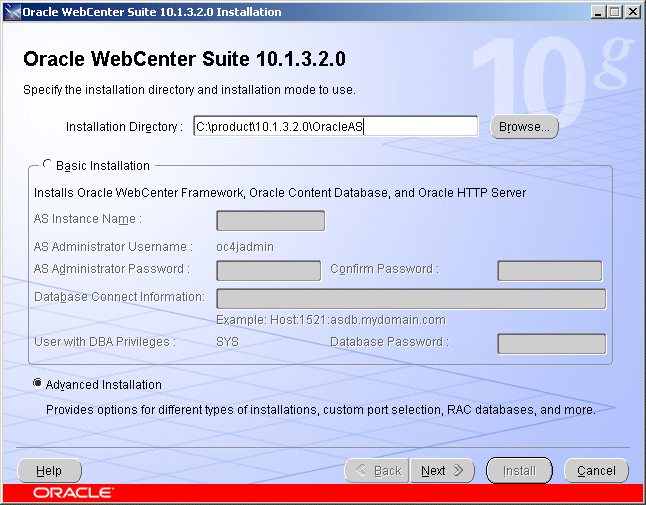
Installation Directory
Specify the full path of the installation directory or Oracle home. This is the directory where you want to install the software. For more information about the Oracle home, refer to Section 3.1, "Oracle Home Directory".
Select Basic or Advanced Installation
In this chapter you are performing an advanced installation of Oracle Application Server, so select Advanced Installation and click Next.
If you want to perform a basic installation, see Chapter 4, "Basic Installation".
After you click the Next button, the following warning appears:
Click Yes to continue with the advanced installation.
Select the product you want to install, then click Next.
Figure 5-3 Oracle Universal Installer: Select Installation Type Screen

To learn what components are installed with the different installation types, see Section 5.1, "What Components Are Installed?".
On this screen, you can install additional languages by clicking on Product Languages. See Section 3.3, "Installing Additional Languages" for more information.
Select the method in which you want to configure ports.
Figure 5-4 Oracle Universal Installer: Specify Port Configuration Options Screen

Click Automatic if you want to use all default port numbers. Refer to Appendix C for a list of all the default port numbers and ranges.
Click Manual if you want to customize your port numbers. You must supply the full path and file name to an existing port configuration file containing the port numbers you want to use for each component. Typically, this port configuration file is called staticports.ini, although any name is valid as long as the format of the file is correct. Refer to Section 2.5.4, "Using Custom Port Numbers (the "Static Ports" Feature)" for more information about the staticports.ini file that is shipped with the product.
Specify the Oracle Application Server instance name and oc4jadmin password. Select if you want to start Oracle Enterprise Manager 10g Application Server Control.
Figure 5-5 Oracle Universal Installer: Administration Settings Screen
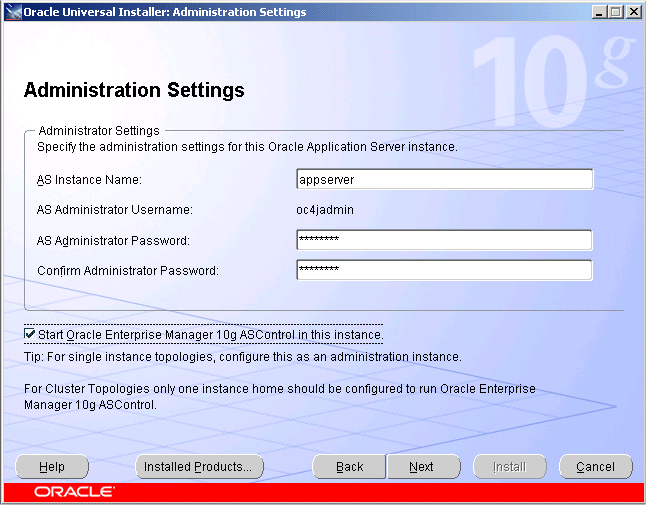
AS Instance Name
The AS Instance Name uniquely identifies this Oracle Application Server instance.
For more information about instance names, see Section 3.3, "Oracle Application Server Instances and Instance Names".
AS Administrator Username
The administrator username for Oracle Application Server instances is set to oc4jadmin and cannot be changed. To manage Oracle Application Server instances using Enterprise Manager, log in as the oc4jadmin user.
For more information about the oc4jadmin user, see Section 3.4, "The oc4jadmin User and Restrictions on its Password".
AS Administrator Password and Confirm Administrator Password
On a host, you can install multiple Oracle Application Server instances, each with its own unique instance name, but the name of the administrative user is oc4jadmin for all instances. You can specify a different password for the oc4jadmin user for each instance.
For more information about the oc4jadmin password, see Section 3.4, "The oc4jadmin User and Restrictions on its Password".
Start Oracle Enterprise Manager 10g ASControl in this instance
Select this option if you want to run Application Server Control on this system to provide management capabilities.
If you are using a single instance topology, you should select this option to be able to manage the instance.
If you are using a cluster topology, you should select this option if you want this instance to administer the cluster using Application Server Control. In a cluster topology, only one instance should be configured as an Administration OC4J instance. Note that the Administration OC4J instance for the cluster does not have to be the first installed node.
If you do not select Start Oracle Enterprise Manager 10g ASControl in this instance, then Application Server Control will be configured to not run on this system. This Application Server instance will need to be managed by Application Server Control running on another OC4J instance within the cluster topology. You can configure the Application Server Control to run on this instance following installation if required. See "Managing the Active Application Server Control" in the Oracle Application Server Administrator's Guide for details.
This screen only appears if you select the Oracle Content Database option on the Select Installation Type screen shown in Figure 5-3.
Figure 5-6 Oracle Universal Installer: Specify Database Information Screen

Username
The DBA user is set to "SYS" and cannot be changed.
Password
Specify the password for the database user SYS in the Password field.
Hostname and Port
Specify the hostname and port for the database in the Hostname and Port field. The format should be hostname:port. If the Oracle Database is a Real Application Clusters (RAC) database, specify the hostname and port using the format virtual_hostname_on_node1:port^virtual_hostname_on_node2:port^virtual_hostname_on_node3:port. Use the caret (^) character to separate the values.
Service Name
Specify the service name of the database in the Service Name field. This is typically the same as the global database name. If you are unsure what the service name for your database is, you can obtain it from the SERVICE_NAMES parameter in the database's initialization parameter file. If the initialization parameter file does not contain the SERVICE_NAMES parameter, then the service name is the same as the global database name, which is specified in the DB_NAME and DB_DOMAIN parameters. If the database is in a Real Application Clusters database, all the instances of the database must have the same service name.
This screen only appears if you select the Oracle Content Database option on the Select Installation Type screen shown in Figure 5-3.
Figure 5-7 Oracle Universal Installer: Specify Content Database Schema Password Screen
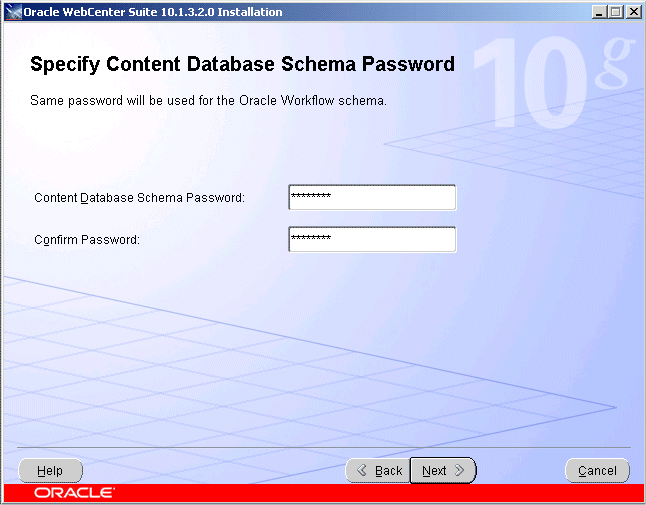
If this is the first Oracle Content DB middle tier you are installing, enter the password you want to use for the Oracle Content DB schema. The Oracle Content DB schema name is CONTENT. This schema will be created during this installation. The same password will also be used for Oracle Workflow schema.
If this is a subsequent Oracle Content DB middle tier, enter the schema password for the existing Oracle Content DB schema.
This screen only appears if you select the Oracle Content Database option on the Select Installation Type screen shown in Figure 5-3.
Figure 5-8 Oracle Universal Installer: Specify User Repository Screen

Select the type of repository you want to use (File-Based or Directory-Based).
Note:
You cannot change the user repository type postinstallation.If you select the Directory-Based repository type:
In the Directory Type field, select one of the following:
Oracle Internet Directory
Active Directory
Sun Directory Server
eDirectory
OpenLDAP
Note:
If you plan to use Oracle Drive with Oracle Content DB and you are not using Oracle Internet Directory as a user repository, you must configure Oracle Content DB for SSL. See "Setting Up SSL for Client Connections to Oracle Content DB" in Oracle Content Database for Oracle WebCenter Suite Administrator's Guide.In the Host Name and Port field, enter the host name of the computer hosting the directory server. Then, enter the port number on which the directory server is listening. For example:
fully_qualified_host_name:port_number
If the specified port is SSL-enabled, click the Select if this is an SSL port option.
Note:
If you are using an LDAP server other than Oracle Internet Directory, you must specify a non-SSL port. You can configure SSL postinstallation. See Oracle Content Database for Oracle WebCenter Suite Administrator's Guide for more information.
If you are using Oracle Internet Directory, and you want to specify an SSL port, you must set up Oracle Internet Directory for SSL in advance. SSL is recommended in production environments.
In the User DN field, enter the directory superuser name, or the distinguished name (DN) of another user with administrative privileges.
In the Password field, enter the password for the user DN.
If you selected Oracle Internet Directory in the Directory Type field, the remainder of this screen is not applicable. Click Next to continue with the installation. If you selected any of the other directory types, you must fill out the remaining fields on this screen:
In the User Search Base field, enter a user search base of the LDAP server. For example:
"cn=users,dc=us,dc=abc,dc=com"
Only the users in the search base you enter will have access to Oracle Content DB.
In the LDAP User Name Attribute field, enter the LDAP user name attribute. For example:
cn
uid
Oracle Content DB user names will correspond to the LDAP user name attribute you specify. For example, if you choose mail, Oracle Content DB users will use their e-mail addresses to log in to Oracle Content DB.
In the LDAP User Object Class field, enter a list of LDAP schema object classes used to represent a user. Use spaces to separate multiple object classes.
In the Site Administrator User field, specify the Oracle Content DB site administrator user. The site administrator has all Oracle Content DB application administration roles. Depending upon what kind of user repository you are using, the site administrator user can be different.
If you are using a file-based user repository, the site administrator user is contentadmin. The password for this user is the same as the Oracle Content DB schema password.
If you are using Oracle Internet Directory, the site administrator user is orcladmin.
If you are using a third-party LDAP user repository, specify (at install time) a user that already exists in the third-party user repository. This user will be granted all the roles and can then be used as the site administrator user.
You cannot specify a DN in the Site Administrator User field. You must specify a user name that corresponds to the LDAP user name attribute you chose. For example, if you chose mail as the LDAP user name attribute, enter the e-mail address of the user.
Note:
If this is a subsequent Oracle Content DB middle tier installation, and you are using a file-based user repository, the Specify User Repository screen does not appear.If this is a subsequent Oracle Content DB middle tier installation, and you are using either Oracle Internet Directory or a third-party LDAP server, enter only the user DN and password for the LDAP server on this screen.
This screen only appears if you select the Oracle HTTP Server option on the Select Installation Type screen shown in Figure 5-3.
Figure 5-9 Oracle Universal Installer: Specify Instance Name Screen

Instance Name
Specify the Oracle Application Server instance name. The instance name uniquely identifies this Oracle Application Server instance.
For more information about instance names, see Section 3.3, "Oracle Application Server Instances and Instance Names".
Select whether you would like to configure this instance to be part of an Oracle Application Server cluster topology.
Figure 5-10 Oracle Universal Installer: Cluster Topology Configuration (Oracle WebCenter Framework with Oracle HTTP Server)
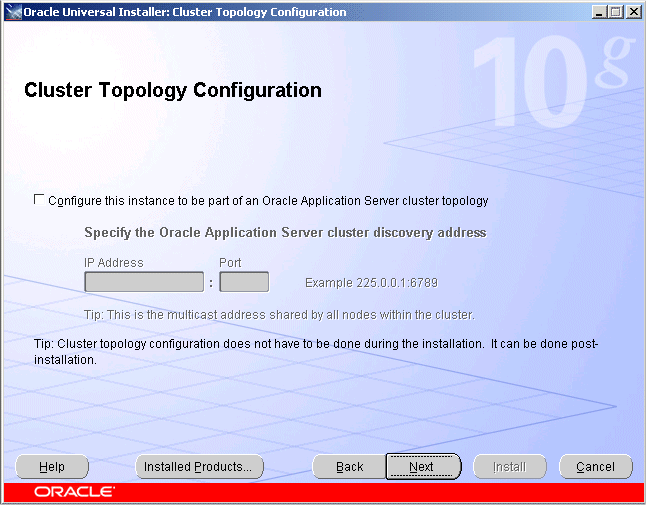
Configure this instance to be part of an Oracle Application Server cluster topology
Select this option if you would like to configure this instance to be part of an Oracle Application Server cluster topology. You may also configure the cluster topology following installation. See Section 7.3, "Configuring OracleAS Clusters" for details.
Specify the Oracle Application Server cluster discovery address
Specify the IP Address and the Port for the multicast address shared by all the nodes in the cluster.
Note:
When installing the first instance of the cluster, you only need to provide the discovery address. You do not need to perform any additional steps before installing the first instance of the cluster.
All nodes within the topology must be configured to use the same multicast address and port.
The multicast address must be within the valid address range, which is 224.0.1.0 to 239.255.255.255.
If you are adding an instance to an existing cluster and do not know the multicast address, find the <discover> element in the opmn.xml file on an Oracle Application Server instance in the topology. The <discover> element should appear like this:
<notification-server>
<topology>
<discover list="*225.0.0.20:8001"/>
</topology>
...
</notification-server>
In this example, the IP address is 225.0.0.20 and the port is 8001.
Select whether you would like to configure this instance to be part of an Oracle Application Server cluster topology.
Figure 5-11 Oracle Universal Installer: Cluster Topology Configuration (Oracle Content Database)

Configure this instance to be part of an Oracle Application Server cluster topology
Select this option if you would like to configure this instance to be part of an Oracle Application Server cluster topology. You may also configure the cluster topology following installation. See Section 7.3, "Configuring OracleAS Clusters" for details.
Specify the Oracle Application Server cluster discovery address
Specify the IP Address and the Port for the multicast address shared by all the nodes in the cluster.
Note:
When installing the first instance of the cluster, you only need to provide the discovery address. You do not need to perform any additional steps before installing the first instance of the cluster.
All nodes within the topology must be configured to use the same multicast address and port.
The multicast address must be within the valid address range, which is 224.0.1.0 to 239.255.255.255.
If you are adding an instance to an existing cluster and do not know the multicast address, find the <discover> element in the opmn.xml file on an Oracle Application Server instance in the topology. The <discover> element should appear like this:
<notification-server>
<topology>
<discover list="*225.0.0.20:8001"/>
</topology>
...
</notification-server>
In this example, the IP address is 225.0.0.20 and the port is 8001.
Select whether you would like to configure this instance to be part of an Oracle Application Server cluster topology.
Figure 5-12 Oracle Universal Installer: Cluster Topology Configuration (Oracle WebCenter Framework)

Configure this instance to be part of an Oracle Application Server cluster topology
Select this option if you would like to configure this instance to be part of an Oracle Application Server cluster topology. You may also configure the cluster topology following installation. See Section 7.3, "Configuring OracleAS Clusters" for details.
Specify the Oracle Application Server cluster discovery address
Specify the IP Address and the Port for the multicast address shared by all the nodes in the cluster.
Note:
When installing the first instance of the cluster, you only need to provide the discovery address. You do not need to perform any additional steps before installing the first instance of the cluster.
All nodes within the topology must be configured to use the same multicast address and port.
The multicast address must be within the valid address range, which is 224.0.1.0 to 239.255.255.255.
If you are adding an instance to an existing cluster and do not know the multicast address, find the <discover> element in the opmn.xml file on an Oracle Application Server instance in the topology. The <discover> element should appear like this:
<notification-server>
<topology>
<discover list="*225.0.0.20:8001"/>
</topology>
...
</notification-server>
In this example, the IP address is 225.0.0.20 and the port is 8001.
Access this OC4J Instance from a separate Oracle HTTP Server
Select this option if you want the OC4J instance to accept requests from an Oracle HTTP Server instance. If you select this option, then the OC4J instance will be configured so that its default web site is running in AJP protocol mode and accepts requests from mod_oc4j running in Oracle HTTP Server.
If you do not select this option, the OC4J instance will listen for requests from browser clients using its own HTTP listener. The OC4J instance will be configured so that its default web site is running in HTTP protocol mode and can be directly accessed from browser clients.
You can change how this OC4J instance is accessed following installation. See "Configuring Multicast Discovery with opmnctl" in the Oracle Containers for J2EE Configuration and Administration Guide.
Select whether you would like to configure this instance to be part of an Oracle Application Server cluster topology.
Figure 5-13 Oracle Universal Installer: Cluster Topology Configuration (Oracle HTTP Server)
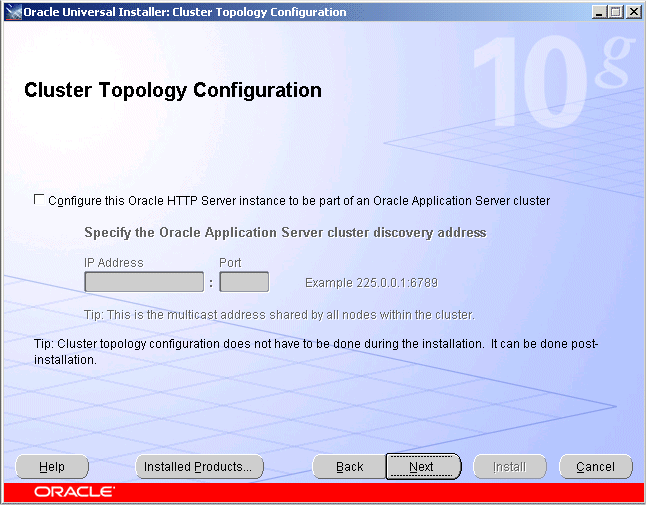
Configure this Oracle HTTP Server instance to be part of an Oracle Application Server cluster
Select this option if you would like to configure this instance to be part of an Oracle Application Server cluster. You may also configure the cluster following installation. See Section 7.3, "Configuring OracleAS Clusters" for details.
Specify the Oracle Application Server cluster discovery address
Specify the IP Address and the Port for the multicast address shared by all the nodes in the cluster.
Note:
When installing the first instance of the cluster, you only need to provide the discovery address. You do not need to perform any additional steps before installing the first instance of the cluster.
All nodes within the topology must be configured to use the same multicast address and port.
The multicast address must be within the valid address range, which is 224.0.1.0 to 239.255.255.255.
If you are adding an instance to an existing cluster and do not know the multicast address, find the <discover> element in the opmn.xml file on an Oracle Application Server instance in the topology. The <discover> element should appear like this:
<notification-server>
<topology>
<discover list="*225.0.0.20:8001"/>
</topology>
...
</notification-server>
In this example, the IP address is 225.0.0.20 and the port is 8001.
Check and verify that the installation parameters shown in this window are correct.
Figure 5-14 Oracle Universal Installer: Summary Screen

Click Install to begin the installation.
This screen shows the progress of the installation.
Figure 5-15 Oracle Universal Installer: Install Screen
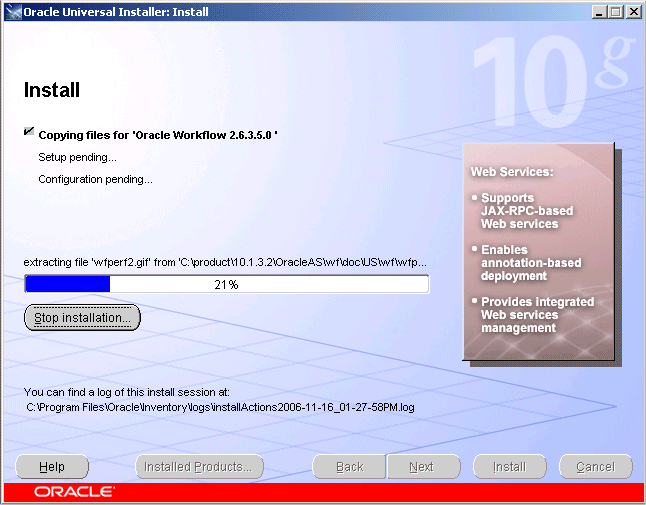
Click Stop Installation if you want to abort the installation. You will be asked to verify that you want to stop the installation.
This screen also provides the location of the install log, in case you want to view the contents of the log.
This screen shows the name, status, and tool type for tools recommended to be run before completing the installation.
Figure 5-16 Oracle Universal Installer: Configuration Assistants Screen
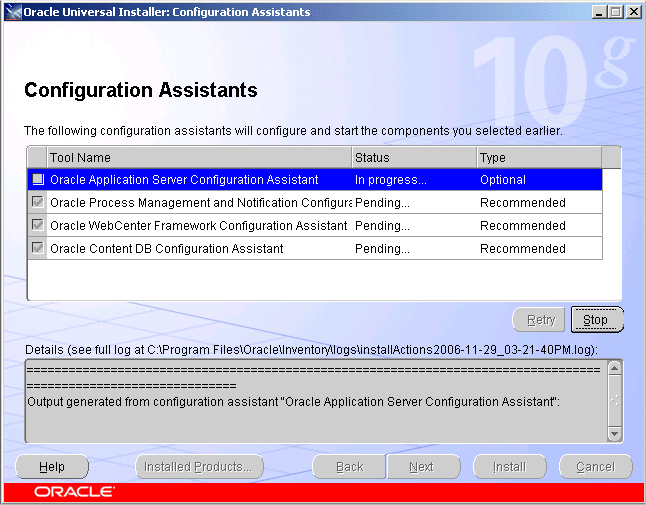
A tool may have one of the following states, as shown in the status column:
Succeeded: The tool ran successfully.
Failed: The tool ran, but failed.
Pending: The tool is waiting to run.
Cancelled: The tool was cancelled by the user (by clicking Stop).
In Progress: The tool is currently running.
Skipped: A configuration assistant running before this tool was cancelled or failed. Tools that follow a failed or cancelled tool are skipped.
When you select a tool, its details are shown in the Details box. Details are displayed as the tool is running. If you want to stop a configuration assistant while it is running, click Stop.
Note:
Do not stop the Oracle Content DB Configuration Assistant. If you stop the Oracle Content DB Configuration Assistant, the installation will fail.If the Oracle Content DB Configuration Assistant is stopped or fails, follow the steps in Section D.3, "Additional Deinstallation Tasks for Oracle Content DB" before attempting to install again. Do not click Retry.
You can find the Oracle Content DB Configuration Assistant log in the following location:
ORACLE_HOME/content/log/ContentConfig.log
If all tools succeed on the first try, OUI automatically proceeds to the next page. Otherwise, OUI remains on the Configuration Assistants page until all tools are successful. You can then click Next to proceed.
If one or more tools fail, OUI does not proceed to the next page. Instead, you can read the details of failed tools, fix the problems, and try running the configuration assistant again. You should also consult the installation document for the product being installed for instructions on what to do if a tool fails. For all failed or skipped tools, OUI generates a list of the tool names and the commands used to run them; you can copy/paste this information directly into a shell script or batch file to run these tools after installation is complete.
By default, the check box in the Retry column will be checked for all tools that failed or were skipped. To retry all checked configuration assistants, click Retry.
To continue without fixing the problem, click Next.
Note:
The installation is considered successful even if all configuration assistants failed, irrespective of their type (Recommended or Optional). However, failing to successfully run all recommended tools results in an improperly configured product that may not function.This screen tells you whether or not your Oracle Application Server installation was successful and displays some important information that you must remember about the products you have installed. For example, it might contain information about the URLs for particular Web applications. Write down this information so that you can remember it.
This information can also be found in the ORACLE_HOME\install\readme.txt file.
Figure 5-17 Oracle Universal Installer: End of Installation

To view the Welcome Page for the product you have installed, click Release Information. The Welcome Page provides product information, demos, and documentation.
Click Exit to exit the Oracle Universal Installer.
If you encounter any problems with the installation, configuration assistants, or product in general, refer to Appendix F, "Troubleshooting" for common problems and solutions.
After the installation is complete, you should:
Refer to Chapter 7 for instructions and information about postinstallation tasks you should perform.
Refer to the Oracle Application Server Administrator's Guide for information about how to configure, administer, and manage Oracle Application Server after it has been successfully installed.